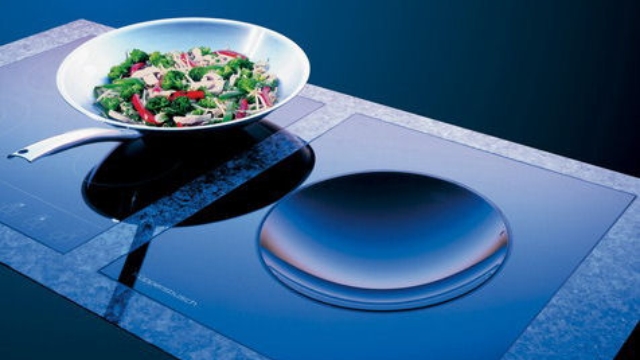The Induction Site
Search this site, or just roll your cursor over the colored boxes below the pictures.Advertisement:
Advertisement:
Advertisement:
Advertisement:




"Every man shall eat in safety under his own vine what he plants."
—Shakespeare
Quick page jumps:
Induction cooking units work by generating a field of electromagnetic energy. Concerns have been expressed from time to time about whether such fields--from induction cookers, microwave ovens, cell phones, or any of a variety of other sources--might be some sort of health hazard to humans. These risks--if they arise--would be from the interaction of the radiation with the human body. A major report from a science body of the European Union, which we will cite in detail later, lists as issues they were charged with investigating some ten possible matters: immune-system effects; cardiac effects; nervous-system effects; neurobehavioral effects (this arises only with respect to cell-phone use while driving); ocular effects; miscellaneous other than cancer; genotoxicity; experimental carcinogenesis (meaning effects noted in laboratory studies); melatonin production; and epidemiological carcinogenesis (meaning statistical suggestions of a carcinogenic effect).
That laundry list of horrors seems daunting, but keep clearly in mind that those were the questions asked, not the answers found. The study committee did no research of its own, but rather reviewed the extremely extensive scientific literature on the subjects at issue--in effect, combining the results of many studies into one.
While we're at it, we should also emphasize the importance of distinguishing two health issues relating to "electromagnetic radiation" that are each quite distinct from whatever issues there might be for induction cookers. That distinguishing is important, because many "information" sources--which often don't understand these things themselves--fail to make those important distinctions, and lump up all "radiation" concerns into one matter--something like failing to distinguish between the risk of being hit by a moving truck as compared with the risk of being hit by a falling meteor.
One such important distinction is between "ELF" (Extremely Low Frequency) radiation, such as that from power lines, and the microwave "RF" (Radio Frequency) radiation of the sort induction unit can produce. There has been much fuss (though so far too few meaningful data) about ELF, especially from power lines, because its radiation covers a lot of physical ground; but microwave RF peters out in very short distances if not "guided" by some physical structure (such as a radar unit's "wave guide"). The RF field from an induction cooker unit dies away to almost nothing at a distance of about one foot (30 centimeters), so you're not even going to get any nontrivial radiation from an induction cooker unless you spend an awful long time well within one foot of a running element.
The other important distinction is between things like an induction cooker or a microwave oven and cell phones. Though so far the evidence for ill effects from heavy cell-phone use is controversial, the fact remains that the issue arises at all only because a cell phone's microwave-radiating antenna is, in normal use, essentially pressed up as close as it can be gotten to the human brain. Even with a layer of bone between, we're talking distances of an inch or two to an actual transmitter of microwaves. Unless you press your ear to your induction cooktop for hours a day, cell-phone data, and concerns, are largely irrelevant.
Certain persons might potentially be at greater risk from radiation effects than the general population. One class is those with implanted cardiac devices--pacemakers or defibrillators--who need to know if their devices can be affected by induction-cooker radiation; we will examine that issue farther below, separate from the general-risk issues. The second class, whose very existence is debatable, is persons with an extraordinarily unusual degree of sensitivity to high-frequency energy. The existence of that last class rests solely on the basis of some few scattered anecdotal reports. (One would think that persons having such remarkable sensitivities would be aware of them, since cell phones or even well-shielded microwave ovens might be supposed sufficient to cause them awareness.)
While we want to emphasize that we are not physicians or in any way medically trained, our review of the literature available on the internet leads us to believe that there is no cause for concern about induction-cooker radiation for, at the least, the general public.
We base that conclusion on many readings, but the easiest to cite is the report we mentioned a little above, the European Commission Directorate-General of Health and Consumer Protection's Scientific Committee on Toxicity, Ecotoxicity and the Environment's formal Opinion on Possible effects of Electromagnetic Fields (EMF), Radio Frequency Fields (RF) and Microwave Radiation on human health. Their conclusions on microwave radiation begin on Page 6 thereof; they are too long to present in full, but here are some brief paraphrases of their findings, which you should read in full if this subject is of deep interest to you.
Immune system: The effects were be transitory, returning to normal levels following termination of exposure. No consistent effects of low-level RF exposure have been reported.
Heart and blood pressure: The issue does not even arise except with respect to cell phones (where, in any event, no effect was found).
Nervous system: Evidence for any effect at all has been "inconsistent and unconvincing".
Neurobehavioral effects: another cell-phone-related issue--effects on driving (with, again, little or no evidence anyway).
Ocular effects: The eye is a potential RF/microwave target because it is not protected by bone and the fibers that make up most of the lens have a limited self-repair capacity. The literature on the ocular effects of microwaves in laboratory animals is extensive, but results are still controversial (substantial interspecies differences have been noticed). Lens cataracts have been produced after exposure to very high frequencies, but it is not clear whether the effect is due to thermal changes [a "thermal change" means, in effect, localized cooking]. Thus, the relevance of current knowledge to human risk from anything other than thermal effects is very limited. [So, unless your eyeball gets, in effect, partly cooked, requiring pretty heavy radiation doses, it's unlikely that there will be any harm done to your eyes; radar repair personnel are instructed not to look down the "wave guide" of a functioning unit, but an induction cooker is not a sky-piercing radar unit.]
Health outcomes other than cancer: There is "no consistent evidence" of any problems, but "this cannot be taken to mean that RF and microwaves do not pose any hazard to human health." There have been [as we noted above] occasional "reports of small series of cases of subjective symptoms (fatigue, stress, sleep disturbances, depression, burning sensations, rashes, muscular pain, ear, nose, and throat problems, as well as digestive disorders etc.) in individuals that have been characterised as 'hypersensitive'" [emphasis added]. "Limited studies on volunteers found no connection between reported symptoms and exposure to electromagnetic fields. It is therefore very difficult to ascertain whether these are true effects." [Emphasis again added]
Genotoxicity: A careful overview of data concluded that there are no strong indications that fields of the sort at issue here cause any DNA damage.
"Experimental" carcinogenesis: "Results have been essentially negative."
Effects on melatonin production: Recent studies on human volunteers, plus well-designed studies on mice, have not provided any evidence of such an effect.
"Epidemiological studies" on the association between RF magnetic fields and human cancer: Overall, the epidemiological evidence of RF and microwaves does not suggest consistent cancer excesses. [Note that almost all of this really pertains to cell-phone use, where the microwave source is literally next to the brain.] That is consistent with the lack of evidence of genotoxic effects believed to be associated with the process of carcinogenesis.
Put them all together, and they spell . . . . Well, all we can say is that we like to think ourselves very careful persons, especially with our health, and we merrily cook away with an induction cooktop.
As to those with the special concern of having an implanted cardiac device, while you should make your own evaluation, the scientific literature seems to strongly suggest safety. We present below what seemed to us the "highlight phrases" from several Abstracts of learned articles on the subject; in each case, we provide a link to the full Abstract (the full articles are only available online for a fee, but are probably too technical for most of us--that's what "Abstracts" are for).
From "Induction Ovens and Electromagnetic Interference: What is the Risk for Patients with Implanted Pacemakers?", by H. Rickli, M. Facchini, H. Brunner, P. Ammann, M. Sagmeister, G. Klaus, W. Angehrn, R. Luechinger, and F. Duru, which appeared in Pacing and Clinical Electrophysiology, Volume 26, Number 7, July 2003, pp. 1494-1497(4):
In conclusion, this study shows no EMI risk of an induction oven in patients with bipolar or right-sided unipolar pacemakers.
From "Electromagnetic Interference of Implantable Unipolar Cardiac Pacemakers by an Induction Oven" by Minoru Hirose, Mizuho Hida, Eiji Sato, Kenichi Kokubo, Masaki Nie, and Hirosuke Kobayashi, which also appeared in Pacing and Clinical Electrophysiology, at Volume 28, Number 6, June 2005, pp. 540-548(9): [link is to Abstract only: full article requires fees]
Thus, the safe distance from an induction oven of a patient with an implanted cardiac pacemaker is considered to be 50 cm or more.
From "Induction Ovens and Electromagnetic Interference: What Is the Risk for Patients with Implantable Cardioverter Defibrillators?", by Christian Binggeli, Hans Rickli, Peter Ammann, Corinna Brunckhorst, Urs Hufschmid, Luechinger Roger, and Firat Duru, which appeared in Journal of Cardiovascular Electrophysiology, Volume 16, Number 4, April 2005, pp. 399-401(3): [link is to Abstract only: full article requires fees]
Interrogation of the devices after exposure did not show any inappropriate tachycardia detection, oversensing, or reprogramming. In conclusion, ICD patients can be reassured that EMI is unlikely to affect their devices if induction ovens are used in their kitchens.
From "Effects of 50 to 60 Hz and of 20 to 50 kHz magnetic fields on the operation of implanted cardiac pacemakers", by R. Frank, M. Souques, C. Himbert, F. Hidden-Lucet, J. C. Petitot, G. Fontaine, J. Lambrozo, I. Magne, and J. M. Bailly, which appeared (in French) in Arch Mal Coeur Vaiss. 2003 Apr;96 Spec No 3:35-41:
Actual pacemakers do not present any electromagnetic interference with 50 Hz and 60 Hz or induction cooktop frequency working. They are insensitive with medically correct settings. Unusual high sensitivity leads only to noise reversion mode, or transient ventricular tracking.
From Do induction cooktops interfere with cardiac pacemakers?, by Werner Irnich and Alan D. Bernstein, which appeared in Europace 2006 8(5):377-384; doi:10.1093/europace/eul014:
Patients are at risk if the implant is unipolar and left-sided, if they stand as close as possible to the induction cooktop, and if the pot is not concentric with the induction coil.
From Β-Field Exposure From Induction Cooking Appliances, by Clementine Viellard, Albert Romann, Urs Lott, and Niels Kuster; Zurich, July 2006 (revised July 2007):
[No single salient quotation presented itself in this highly technical paper, which examines field strength under what strike us as remarkably unrealistic worst-case conditions--several cooking vessels all severely misaligned on their elements, and the user with 10 to 12 inches of the element for substantial lengths of time; but you can read it for yourself.]
But if you have such an implant and have questions, consult your cardiologist. Don't put your life in the hands of strangers on the internet (not even us).
Advertisement:
Advertisement:
All content copyright © 2002 - 2025 by The Owlcroft Company.
This web page is strictly compliant with the W3C (World Wide Web Consortium) Extensible HyperText Markup Language (XHTML) Protocol v1.0 (Transitional) and the W3C Cascading Style Sheets (CSS) Protocol v3 — because we care about interoperability. Click on the logos below to test us!
This page was last modified on Monday, 22 January 2024, at 12:46 am Pacific Time.